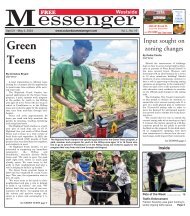You also want an ePaper? Increase the reach of your titles
YUMPU automatically turns print PDFs into web optimized ePapers that Google loves.
PAGE 12 - MADISON MESSENGER - <strong>April</strong> 18, <strong>2021</strong><br />
www.madisonmessengernews.com<br />
Watch for details about the <strong>Madison</strong><br />
County Master Gardners’ new “Ask A<br />
Master Gardener” Help Line,<br />
coming soon.<br />
#1 in CENTRAL OHIO<br />
GILBERTS<br />
Masonry/Restoration Co.<br />
614-946-8871<br />
Lic.-Bonded-Insured<br />
32 Years in Business<br />
• Brick • Block • Stone<br />
• Cultured Stone • Stucco<br />
• Concrete • Tuck Pointing<br />
• Chimney Work<br />
• Glass Block Windows<br />
• Basement Waterproofing<br />
Free Estimates<br />
Tough love aids transition to outside<br />
By Marlene Dorko<br />
<strong>Madison</strong> County Master Gardener<br />
Whether started at home or purchased<br />
from a greenhouse or big box store, indoor<br />
grown plants will benefit from some tough<br />
love before being planted outside.<br />
Plants grown in the sheltered environment<br />
of a greenhouse are ill prepared to<br />
withstand the hot blazing sun, drying<br />
winds, heavy rains and near freezing nights<br />
that are all part of the spring norm here in<br />
Ohio. Placing greenhouse plants directly<br />
into the garden environment can cause<br />
them to go into shock, stopping growth,<br />
damaging foliage and possibly even killing<br />
the plant.<br />
Hardening off is a process that can help<br />
transition plants from the nearly ideal conditions<br />
of the greenhouse to the harsher environment<br />
of the outdoors. It should be<br />
started 10 days to two weeks before the<br />
planned planting date. Outdoor temperatures<br />
should be above 45 degrees.<br />
A few days before starting the hardening<br />
off process, reduce watering of indoor<br />
plants. The soil should be allowed to dry a<br />
bit between waterings but not to the point<br />
MERCHANTS<br />
NATIONAL BANK<br />
where the plants begin to droop. Stop fertilizing<br />
from this point until the plants are<br />
placed in the ground.<br />
Start by setting the plants in a shady<br />
sheltered place for two to three hours. Depending<br />
on outside temperatures, you may<br />
want to do this during the warmest part of<br />
the day. An open garage, shaded porch or<br />
under the dappled shade of a tree are good<br />
places. A cold frame can be a great place to<br />
harden off, provided you are able to control<br />
the amount of exposure to sun and wind.<br />
Each day, increase the time spent outdoors<br />
by an hour or two. Gradually increase<br />
the plants’ exposure to sun and wind by<br />
moving them into more open areas of sunlight.<br />
Watch the plants for signs of stress,<br />
such as wilting or drying leaf edges. Monitor<br />
soil moisture carefully. Small containers can<br />
dry out quickly on sunny, windy days. If the<br />
soil feels moist but the plants are wilting,<br />
cut back on the amount of sun/wind exposure.<br />
After plants are in full sun for 10 to 12<br />
hours per day, begin leaving the plants out<br />
overnight. If there is a frost warning, move<br />
plants inside until temperatures warm to<br />
above 45 degrees. Once plants have been<br />
outside a few full days and nights, they are<br />
Hardening off is a process that can help<br />
transition plants from the nearly ideal conditions<br />
of the greenhouse to the harsher environment<br />
of the outdoors.<br />
ready to be planted in the garden.<br />
Try to choose a cloudy windless day for<br />
planting in the garden. If it’s a sunny day,<br />
plant early in the morning or late in the<br />
evening. Give plants a drink of diluted fertilizer<br />
at this time to help get them growing<br />
again.<br />
Hardening off causes the plants to slow<br />
growth. It allows the plants to develop more<br />
roots, accumulate more carbohydrates, reduce<br />
the amount of freeze-prone water in<br />
the leaves and to thicken cell walls in the<br />
leaves and stems. These changes make the<br />
plants better able to handle the variations<br />
in moisture, temperature and air movement<br />
encountered outside. It might still be necessary<br />
to cover plants should a late frost<br />
threaten, but the plants will be much less<br />
stressed by the fluctuations in temperature.<br />
These tough sturdy plants will soon catch<br />
up to or even surpass stress damaged plants<br />
put in the ground earlier without the hardening<br />
off process.<br />
ose aren’t worms or<br />
aliens; they’re sprouts!<br />
HOME LOAN SPECIAL<br />
CLOSING COSTS - $495 FIXED RATE LOANS<br />
Limited time Offer! O<br />
Contact Cassie assie Williams<br />
for details!<br />
279 Lafayette StrS<br />
treet, London, Ohio O<br />
43140<br />
Phone: 740-852-4900 Ext. E<br />
50122<br />
email: cwilliams@merchantsnat.com<br />
chantsnat.com<br />
By Barbara J. Myers<br />
<strong>Madison</strong> County Master Gardener<br />
Have you ever cut into a tomato and found<br />
white squiggly-looking things inside? Those<br />
are not worms or aliens that made their way<br />
to the center, but rather tomato seeds that<br />
have started to germinate. This phenomenon—when<br />
seeds start growing while still inside<br />
or attached to the mother plant—is<br />
known as vivipary, Latin for “live birth.” It is<br />
common in certain varieties of tomatoes, peppers,<br />
apple, pears, and some citrus.<br />
Vivipary happens when the hormone<br />
controlling the seed dormancy is exhausted<br />
or runs out, letting the seed grow in the<br />
moist environment inside the fruit. This<br />
warm, moist environment is perfect for germinating<br />
seeds to grow. If the tomato were<br />
left uncut in warm conditions, the new plant<br />
sprout would eventually poke through the<br />
skin of the now decomposing tomato.<br />
These new plants can be potted where<br />
they will grow into a large tomato plants<br />
I cut into this tomato the other day and<br />
thought it was wormy. Actually, the seeds<br />
inside the tomato were sprouting.<br />
and even produce tomatoes. The tomato<br />
will not be a clone of the mother plant, because<br />
it grew from a seed that had to be pollinated<br />
by another tomato flower,<br />
introducing new parent genes into the seed<br />
that will produce the new plant. The tomatoes<br />
off of the plant are entirely edible and<br />
quite possibly delicious. Check out the<br />
seeds inside your fruit or vegetable the next<br />
time you slice into it.


















